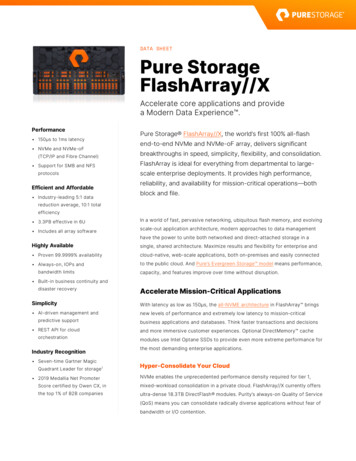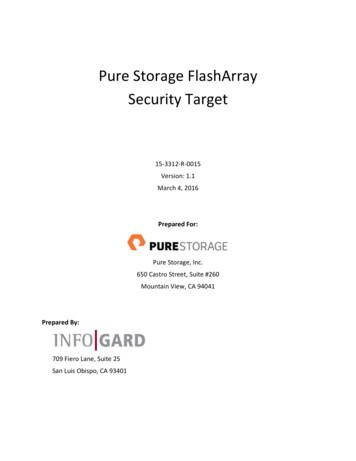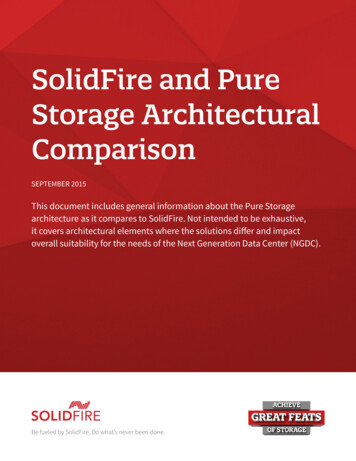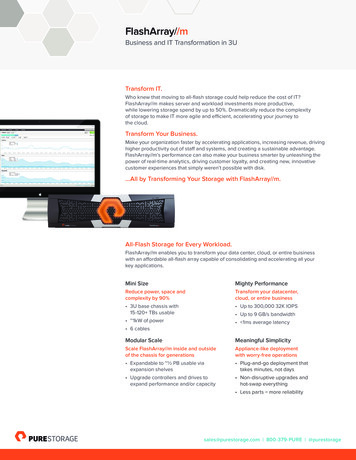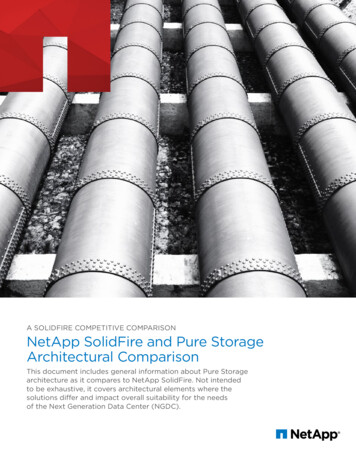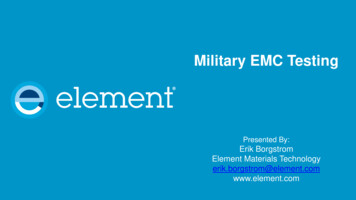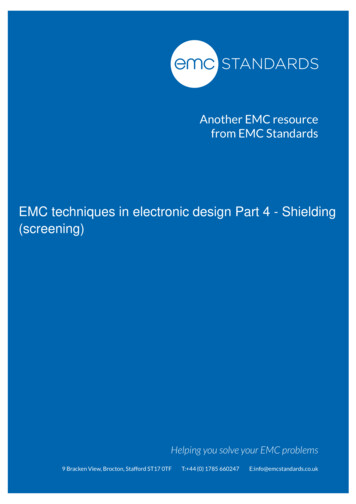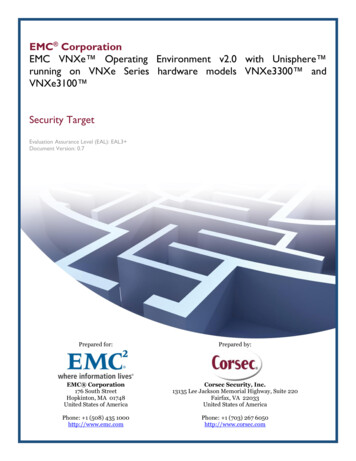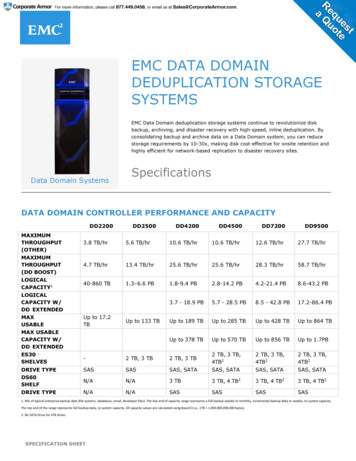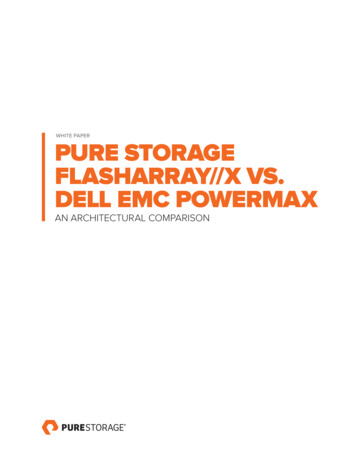
Transcription
WHITE PAPERPURE STORAGEFLASHARRAY//X VS.DELL EMC POWERMAXAN ARCHITECTURAL COMPARISON
TABLE OF CONTENTSOVERVIEW . 3STORAGE EFFICIENCY . 4Dell EMC PowerMax . 4Pure FlashArray//X . 4Comparison . 4STORAGE MANAGEMENT AND AUTOMATION . 5Dell EMC PowerMax . 5Pure FlashArray//X . 6Comparison . 7HIGH AVAILABILITY . 7Dell EMC PowerMax . 7Pure FlashArray//X . 8Comparison . 8ARCHITECTURE . 8Dell EMC PowerMax . 8Pure FlashArray//X . 9Comparison . 9TOTAL COST OF OWNERSHIP (TCO) . 10Dell EMC PowerMax . 10Pure FlashArray//X . 10Comparison . 11SUMMARY . 122
OVERVIEWThis whitepaper provides Pure’s take on an architectural comparison of two industryleading enterprise-class all-flash storage solutions: the Pure Storage FlashArray//X andthe Dell EMC PowerMax.The Pure FlashArray family consists of five different models: the //X10, //X20, //X50, //X70, and //X90 – scaling from20TBe all the way to 3PBe in 6U using a highly available, dual-controller architecture with the ability to non-disruptivelyscale from one model to the next as performance and capacity requirements increase. From its inception, the PureStorage architecture was purpose-built as an all-flash storage array, and is engineered to be able to non-disruptivelyupgrade with data in place and without the need for data migrations.The Dell EMC PowerMax family consists of two models, PowerMax 2000 and 8000, which support maximum capacitiesof 500TBe and 4PBe respectively, in half of a full rack for the PowerMax 2000 and up to two full racks for the PowerMax8000. The PowerMax 8000 scales from one to eight dual-controller engines, now called Bricks, while the PowerMax2000 supports either one or two Bricks with slightly slower and fewer CPU cores than the PowerMax 8000.The PowerMax evolved from EMC’s previous VMAX system, which supported a mix of disk-based and flash storage,and which in turn evolved from EMC’s Symmetrix and Symmetrix DMX systems; these originally supported high-latencyHDD media. EMC’s first use of flash technology was with the addition of flash drives to DMX4 systems in 2008. WhileEMC’s original Symmetrix architecture was designed to overcome the latencies of magnetic, rotating HDDs, in contrastto Pure’s FlashArray, which is now in its fourth generation using NVMe, the Dell EMC PowerMax architecture has beenretrofitted, and now also uses NVMe to communicate to its back-end storage devices – the first generation of itsarchitecture to do so.Although both architectures provide an all NVMe flash storage system that is both highly available and performant,there are many key differences to consider. This paper will examine 5 essential criteria to consider when evaluating anenterprise-class all-flash storage array: Storage Efficiency Storage Management and Automation High Availability Environmentals Total Cost of Ownership (TCO)3
STORAGE EFFICIENCYDell EMC PowerMaxDell has recently acknowledged that the previous VMAX all-flash systems have achievedan average data reduction of 1.98:1 through the use of compression.1 The PowerMax usesa new and different compression algorithm, as well as an additional new post-ingestiondata compression algorithm, so it is reasonable to expect that compression on thePowerMax should be improved over VMAX.Dell EMC, through its Future-Proof Loyalty Program, guarantees a 4:1 storage efficiencyacross its range of all-flash storage arrays, based on a combination of technologies thatinclude compression, deduplication, thin provisioning, and snapshots. However, whenconsidering data reduction alone, which includes compression and deduplication, DellEMC is claiming an average 3:1 data reduction ratio for PowerMax.The PowerMax uses a 128KB comparison size for deduplication, which means that moregranular data is unlikely to get deduplicated. With many applications writing at an 8KBblock size, customers may not achieve significant data reduction from the PowerMaxdeduplication feature unless they are using very large block sizes (greater than 128KB).Additionally, Dell EMC notes that up to the most “active” 20% of data will not receive datareduction at all. Data reduction can be optionally enabled or disabled for each storage group.Pure FlashArray//XThe Pure FlashArray//X is engineered to provide always-ondata deduplication, compression, thin provisioning, encryption,snapshotting, ActiveCluster multi-site synchronous mirroring, Qualityof Service (QoS) without any performance impact. The FlashArray//Xdelivers an average data reduction ratio (compression anddeduplication only) of 5:1 data reduction. When combined with thinprovisioning, the ratio increases to an over 10:1 average total efficiencyrate. Pure Storage provides a simple, all-inclusive storage softwarelicensing model.ComparisonDell EMC is claiming an average data reduction of 50% improvement over the previous generation VMAX 950F, and“up to” 5:1 for PowerMax, but is willing to only guarantee up to 4:1 when including additional potential efficiencies fromthin provisioning and snapshots. 50% improvement over the VMAX 950F’s average of 1.98:1 yields an expectation of2.97:1, which is consistent with Dell EMC’s claimed expectation of 3:1.1https://www.youtube.com/watch?v gBvdXY0WnEg4
The average 3:1 data reduction rate achieved by the PowerMax should be compared to the FlashArray//X’s averagedata reduction rate of 5:1, which provides a 67% improvement over the PowerMax. Similarly, Pure’s 10:1 average totalefficiency should be directly compared to Dell’s 4:1 storage efficiency guarantee claim.In general, the FlashArray//X can deliver total efficiency that is typically 2x more efficient than the PowerMax whenmeasured against comparable data efficiency technologies that include deduplication, compression, and thinprovisioning. In part, this is due to the five different ways in which Pure performs data reduction. With Pure, the lookupdata unit size is 4KB, the lookup data unit alignment is 512B, and for data comparison Pure uses the matched 4KBdata unit as an anchor point to which it then extends the match comparison before and after the anchor point in 512Bincrements until a unique segment found.Comparing Pure FlashArray//X to the Dell EMC PowerMax: The FlashArray//X lookup size is 4KB vs. 128KB. FlashArray//X should find more matches. The FlashArray//X lookup alignment is 512 Bytes vs. 128KB. FlashArray//X is adaptive to various realworld workloads. The FlashArray//X incremental match granularity is 512B vs. 128KB fixed-match. FlashArray//X should beable to deduplicate more data.While the PowerMax provides the customer with the ability to turn data reduction on or off per storage group, whichgives the customer control over what data will be made more efficient, Pure Storage believes that since performanceis not impacted, customers should aim to optimize economics, which are achieved when data reduction is built-in, andalways-on. This also has the benefit of reducing the amount of management.The differences between the two systems become obvious in mission-critical enterprise applications such as those thatuse the Oracle database. For example, if a user is storing Oracle databases on a PowerMax, Pure believes that customerswill not see any benefits from deduplication for primary Oracle databases on PowerMax, since each Oracle block has aunique header that is most likely to misalign with the PowerMax 128KB fixed block lookup. In contrast, Pure FlashArray//Xcan typically provide deduplication value for Oracle databases due to its more granular and variable comparison size.STORAGE MANAGEMENT AND AUTOMATIONDell EMC PowerMaxUnisphere is the primary software set of tools for provisioning, managing, and monitoring PowerMax. It can be run ona dedicated server or run embedded directly in a container on the PowerMax OS hypervisor. In addition to extensivemonitoring features, Unisphere provides a web-based interface to manage many system features, including managinguser accounts, role-based access control, creating thin volumes, masking volumes, setting storage attributes, settingvolume attributes, setting port flags, managing replication and backup operations, managing service levels, workloadplanning, performance troubleshooting, and much more.5
Users have a high degree of control over each of the features available on the PowerMax, and more often than not,users are required to provide their preferences for each of these features as part of the initial configuration and ongoing optimization of the system.To best understand the features and management of the PowerMax, Dell EMC has a 16-hour online learning training.2Pure FlashArray//XPure1 storage management software is a SaaS-based provisioning, management, and monitoring solution thatintegrates with Pure’s proactive support. It leverages machine-learning and predictive analytics to help advisecustomers on optimization and what-if situations, including capacity planning, and performance simulation.Pure1 capabilities are built on a global predictive intelligence engine called Pure1 Meta that leverages theaccumulated data from the thousands of FlashArrays currently deployed. Pure1 Meta is the AI engine within Pure1 thatprovides the intelligence to manage, automate, and proactively support the FlashArray. Pure1 Meta collects more thana trillion telemetry data points of performance data per day. Part of the intelligence of Pure1 comes by way of its abilityto recognize usage patterns. Pure1 identifies known patterns that may affect the optimal operations of FlashArrays,and notifies other FlashArrays with similar usage patterns of the concern. This way, customers are aware of potentialimpacts to their arrays and can proactively take preventive measures.Pure1 is browser-based and can be run without additional software to license, install, upgrade, manage, or changesecurity policies. As new features become available, customers have immediate access to them. And with Pure1,organizations can manage, monitor, and analyze their storage from anywhere with any device, including mobiledevices. Pure1 is consistent with Pure’s mantra of effortless operations, and results in a data platform that is selfmanaging and requires no tuning.In fact, for customers who prefer a command-line interface (CLI), there is usually no need to go beyond what is printedon the business card-sized Getting Started guide included with each FlashArray//X. The guide even includes all thenecessary steps to establish a stretched multi-site replication cluster.FIGURE 1. Pure FlashArray Getting Started home/widgets template4.external.html6
ComparisonUnisphere for PowerMax is highly configurable with many features to leverage. While Dell EMC has added severalautomated tools and tasks to speed up provisioning and management, the overall solution requires significant manualadministrator involvement – not only for initial setup, but for ongoing operational support. The basic differencebetween management of the two platforms in Pure’s opinion is that Unisphere give you extensive tools to performmanagement manually and Pure automates or simply does not require many of those manual interventions.The Pure software management solution can be set up in four easy steps, and once it’s set up the predictiveintelligence and built-in automation makes the solution self-managing and self-healing. In the event that there isan issue, the Pure1 proactive support team will typically know about it and fix it before it becomes a problem.HIGH AVAILABILITYDell EMC PowerMaxAlthough PowerMax is a new system, “PowerMAX is the next generation of the VMAX systems”, “It is the samescale-out architecture [as VMAX]”. 3 The VMAX in turn evolved from Symmetrix DMX systems, which evolved from theoriginal Symmetrix architecture. All of these previous generations of EMC systems established a proven degree ofhigh-availability suitable for mission-critical application environments. Some of the world's most demanding and criticalapplication environments run in production on VMAX, and they almost always deploy multi-site replication with eitherSRDF or VPLEX to achieve the desired level of high-availability.Dell EMC claims that PowerMax arrays are architected for six-nines (99.9999%) availability. Either SRDF/Metro, orVPLEX/Metro are usually configured if the customer desires continuous operations in the event of an array failure.Both SRDF/Metro licenses and VPLEX appliances and licenses, along with the associated professional servicesrequires a significant upfront financial commitment from the customer, along with the associated software maintenancenecessary to sustain the license.One of the promises of the Dell EMC Future-Proof Loyalty Program4 is“Never Worry Migrations”. PowerMax supports “Non-Disruptive Migration”(NDM) for migrations from VMAX to PowerMax. The NDM process flow isshown in Figure2 at right.In the same documentation, Dell EMC warns that “non-disruptive does notalways equal no impact. NDM is designed to migrate a storage group (SG)at a time – not the entire system”.FIGURE 2. PowerMax Non-Disruptive Migration (NDM) process of-loyalty-program.htm5Source: Google7
Pure FlashArray//XPure FlashArray//X and its previous generations have established a proven 99.9999% uptime suitable for missioncritical high-availability with a single system, without the requirement of remote replication to achieve that high degreeof uptime. With Pure’s ActiveCluster, customers have the ability to extend that level of uptime even further.The Purity//FA operating environment that powers the FlashArray//X includes ActiveCluster at no additional cost.ActiveCluster provides the ability to link two different data center sites up to 150 miles apart in an active-active stretchcluster with transparent failover, zero recovery point objective (RPO) and zero recovery time objective (RTO).Pure’s ActiveCluster solution includes Pure1 Cloud Mediator, which is a software-based third entity that monitors thelink between the two sites, and declares which site becomes the primary site, should the link fail. Pure1 Cloud Mediatorruns in the Cloud, so no extra software and no extra hardware, and its associated maintenance, is needed. It can beused to provide rack-level active clustering inside a data center as well as linking separate data centers. A remote thirddata center can also be added for asynchronous replication, which is accessible and live for replication from both ofthe primary arrays in the ActiveCluster.ComparisonUptime and resiliency is a critical factor for mission-critical Tier 1 production applications. Both the VMAX/PowerMaxand FlashArray//X have proven that they can deliver 99.9999% uptime. However, the configuration needed for theVMAX/PowerMax will typically be significantly larger and more complex, and has an associated cost in management,tuning, and operations.ARCHITECTUREDell EMC PowerMaxPowerMax engines or “Bricks” each have two redundant active-active controllers. The PowerMax 2000 supportsup to two Bricks per system, and the PowerMax 8000 supports up to eight Bricks. Bricks own their own Disk ArrayEnclosures (DAEs) which house the NAND flash drives.The PowerMax 2000 can fit up to two Bricks in half a standard 19” rack, while the PowerMax 8000 can fit up to fourBricks in a single rack, and up to eight Bricks across two full racks taking up two full floor tiles.From whatever starting point a PowerMax system is initially configured, it can be grown to its maximum configurationby adding capacity and DAEs to existing Bricks, or in a “scale-out” fashion by keeping all of the existing Bricks andDAEs, and incrementally adding additional Bricks and DAEs, thus potentially increasing the footprint, as well asneeding additional requirements for power and cooling.Historically, any upgrade between generations of VMAX systems required a full “forklift”-style upgrade and a completedata migration from the old system to the new system, as no two generations of engines/Bricks were able to coexist on8
the same system. Pure believes that the same situation has been carried forward to PowerMax, and we are unawareof any claims by Dell to the contrary.Although the PowerMax 2000 is based upon the same architecture as the PowerMax 8000, it is not capable of deliveringthe same “scale-out” features as the PowerMax 8000, since it is limited to a system maximum of only two Bricks. Ina single-brick configuration the PowerMax 2000 is simply a conventional dual-controller system, and in a two-Brickconfiguration it cannot “scale out” any further than its starting point, other than to possibly add capacity or cache.Pure FlashArray//XPure FlashArray//X uses a scale-up storage architecture which allows for a simpler and more flexible upgrade path.Pure’s Evergreen subscription to innovation makes it easy to scale from one model to the next (i.e. //M series //Xfamily) while keeping capacity in place, upgrading controllers non-disruptively, and even while in full-performanceproduction mode.Due to P
Pure Storage provides a simple, all-inclusive storage software licensing model. Comparison Dell EMC is claiming an average data reduction of 50% improvement over the previous generation VMAX 950F, and “up to” 5


